Potential Effects of Climate Change on Australian Agriculture: ANS309
VerifiedAdded on 2022/09/22
|14
|4022
|25
Essay
AI Summary
This essay examines the significant impacts of climate change on Australian agriculture. It begins by highlighting the importance of the agricultural sector to the Australian economy and emphasizes how climate change, particularly in regions like the Murray-Darling Basin and South Western Australia, is negatively affecting agricultural production. The essay cites evidence from the IPCC, predicting declines in agricultural production by 2030 and 2050, and discusses the detrimental effects of reduced rainfall, increased temperatures, and extreme heat on crop yields and livestock productivity. It also analyzes changes in rainfall patterns, rising temperatures, and the depletion of water sources. The essay further explores specific impacts such as altered precipitation patterns, increased temperatures, and the spread of pests and diseases, leading to reduced crop quality, altered migration patterns of pests, and decreased yields of key crops like wheat. The essay concludes by discussing the economic ramifications, including reduced export earnings and the potential for food shortages, emphasizing the urgent need to address climate change to protect the agricultural sector.
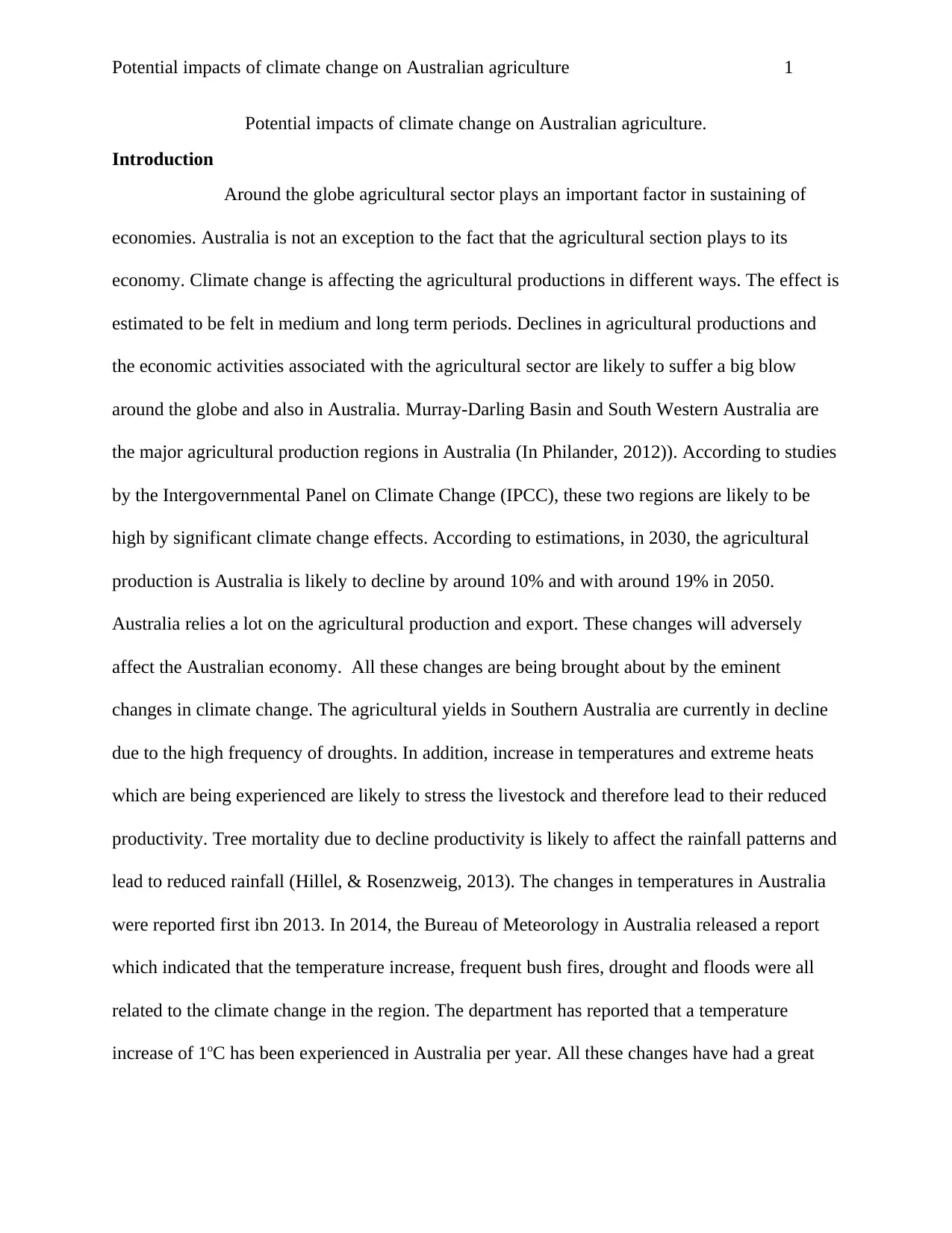
Potential impacts of climate change on Australian agriculture 1
Potential impacts of climate change on Australian agriculture.
Introduction
Around the globe agricultural sector plays an important factor in sustaining of
economies. Australia is not an exception to the fact that the agricultural section plays to its
economy. Climate change is affecting the agricultural productions in different ways. The effect is
estimated to be felt in medium and long term periods. Declines in agricultural productions and
the economic activities associated with the agricultural sector are likely to suffer a big blow
around the globe and also in Australia. Murray-Darling Basin and South Western Australia are
the major agricultural production regions in Australia (In Philander, 2012)). According to studies
by the Intergovernmental Panel on Climate Change (IPCC), these two regions are likely to be
high by significant climate change effects. According to estimations, in 2030, the agricultural
production is Australia is likely to decline by around 10% and with around 19% in 2050.
Australia relies a lot on the agricultural production and export. These changes will adversely
affect the Australian economy. All these changes are being brought about by the eminent
changes in climate change. The agricultural yields in Southern Australia are currently in decline
due to the high frequency of droughts. In addition, increase in temperatures and extreme heats
which are being experienced are likely to stress the livestock and therefore lead to their reduced
productivity. Tree mortality due to decline productivity is likely to affect the rainfall patterns and
lead to reduced rainfall (Hillel, & Rosenzweig, 2013). The changes in temperatures in Australia
were reported first ibn 2013. In 2014, the Bureau of Meteorology in Australia released a report
which indicated that the temperature increase, frequent bush fires, drought and floods were all
related to the climate change in the region. The department has reported that a temperature
increase of 1oC has been experienced in Australia per year. All these changes have had a great
Potential impacts of climate change on Australian agriculture.
Introduction
Around the globe agricultural sector plays an important factor in sustaining of
economies. Australia is not an exception to the fact that the agricultural section plays to its
economy. Climate change is affecting the agricultural productions in different ways. The effect is
estimated to be felt in medium and long term periods. Declines in agricultural productions and
the economic activities associated with the agricultural sector are likely to suffer a big blow
around the globe and also in Australia. Murray-Darling Basin and South Western Australia are
the major agricultural production regions in Australia (In Philander, 2012)). According to studies
by the Intergovernmental Panel on Climate Change (IPCC), these two regions are likely to be
high by significant climate change effects. According to estimations, in 2030, the agricultural
production is Australia is likely to decline by around 10% and with around 19% in 2050.
Australia relies a lot on the agricultural production and export. These changes will adversely
affect the Australian economy. All these changes are being brought about by the eminent
changes in climate change. The agricultural yields in Southern Australia are currently in decline
due to the high frequency of droughts. In addition, increase in temperatures and extreme heats
which are being experienced are likely to stress the livestock and therefore lead to their reduced
productivity. Tree mortality due to decline productivity is likely to affect the rainfall patterns and
lead to reduced rainfall (Hillel, & Rosenzweig, 2013). The changes in temperatures in Australia
were reported first ibn 2013. In 2014, the Bureau of Meteorology in Australia released a report
which indicated that the temperature increase, frequent bush fires, drought and floods were all
related to the climate change in the region. The department has reported that a temperature
increase of 1oC has been experienced in Australia per year. All these changes have had a great
Paraphrase This Document
Need a fresh take? Get an instant paraphrase of this document with our AI Paraphraser
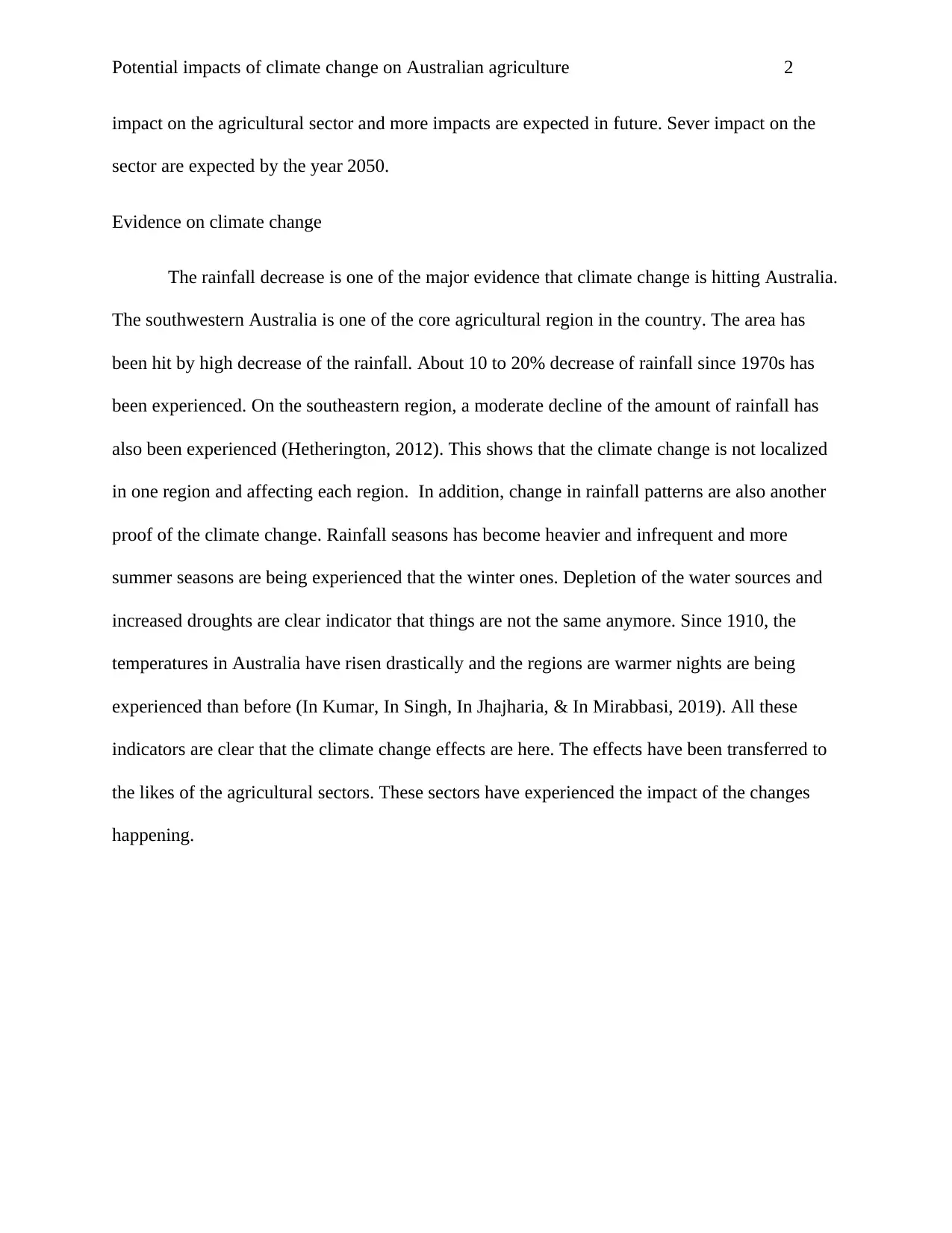
Potential impacts of climate change on Australian agriculture 2
impact on the agricultural sector and more impacts are expected in future. Sever impact on the
sector are expected by the year 2050.
Evidence on climate change
The rainfall decrease is one of the major evidence that climate change is hitting Australia.
The southwestern Australia is one of the core agricultural region in the country. The area has
been hit by high decrease of the rainfall. About 10 to 20% decrease of rainfall since 1970s has
been experienced. On the southeastern region, a moderate decline of the amount of rainfall has
also been experienced (Hetherington, 2012). This shows that the climate change is not localized
in one region and affecting each region. In addition, change in rainfall patterns are also another
proof of the climate change. Rainfall seasons has become heavier and infrequent and more
summer seasons are being experienced that the winter ones. Depletion of the water sources and
increased droughts are clear indicator that things are not the same anymore. Since 1910, the
temperatures in Australia have risen drastically and the regions are warmer nights are being
experienced than before (In Kumar, In Singh, In Jhajharia, & In Mirabbasi, 2019). All these
indicators are clear that the climate change effects are here. The effects have been transferred to
the likes of the agricultural sectors. These sectors have experienced the impact of the changes
happening.
impact on the agricultural sector and more impacts are expected in future. Sever impact on the
sector are expected by the year 2050.
Evidence on climate change
The rainfall decrease is one of the major evidence that climate change is hitting Australia.
The southwestern Australia is one of the core agricultural region in the country. The area has
been hit by high decrease of the rainfall. About 10 to 20% decrease of rainfall since 1970s has
been experienced. On the southeastern region, a moderate decline of the amount of rainfall has
also been experienced (Hetherington, 2012). This shows that the climate change is not localized
in one region and affecting each region. In addition, change in rainfall patterns are also another
proof of the climate change. Rainfall seasons has become heavier and infrequent and more
summer seasons are being experienced that the winter ones. Depletion of the water sources and
increased droughts are clear indicator that things are not the same anymore. Since 1910, the
temperatures in Australia have risen drastically and the regions are warmer nights are being
experienced than before (In Kumar, In Singh, In Jhajharia, & In Mirabbasi, 2019). All these
indicators are clear that the climate change effects are here. The effects have been transferred to
the likes of the agricultural sectors. These sectors have experienced the impact of the changes
happening.
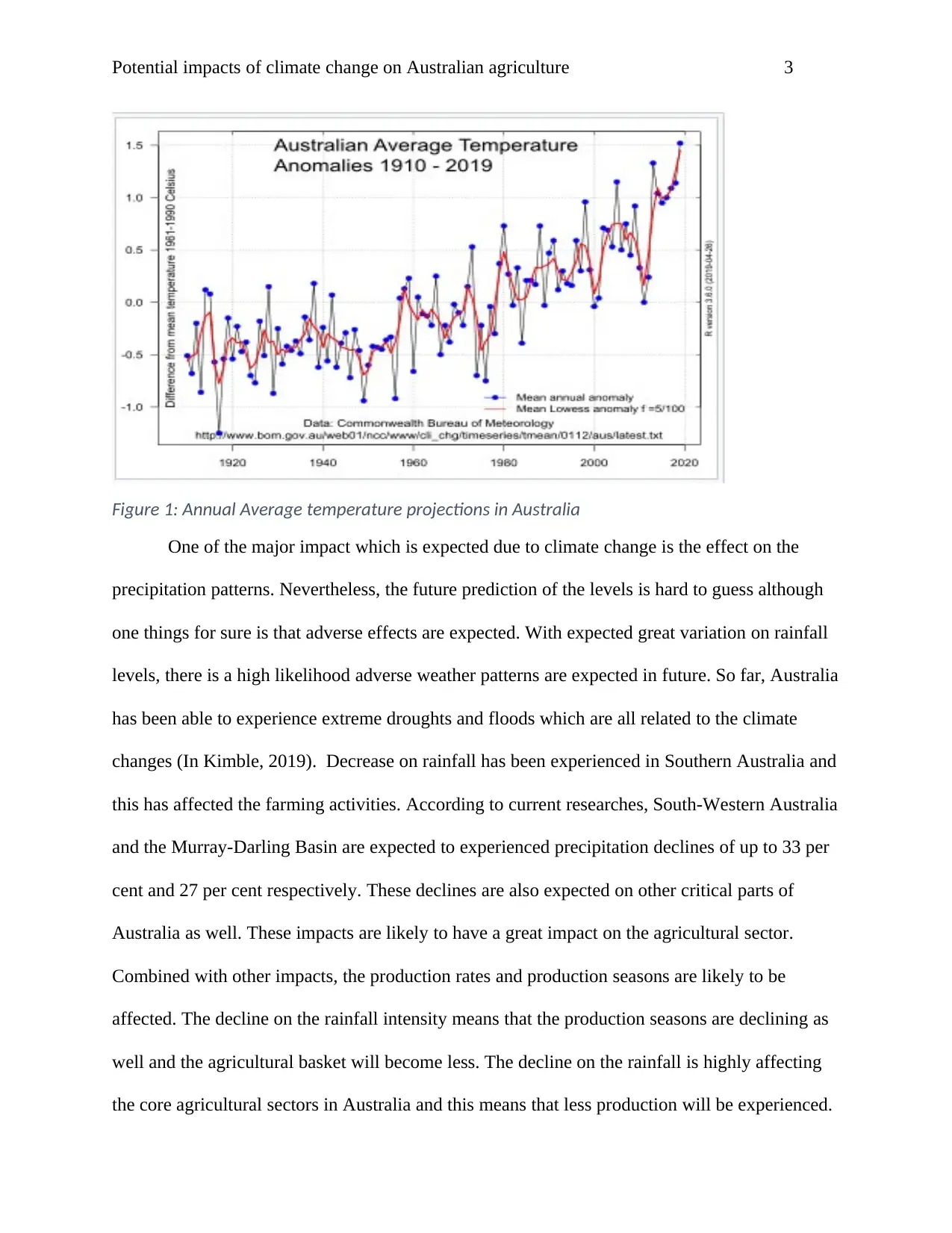
Potential impacts of climate change on Australian agriculture 3
Figure 1: Annual Average temperature projections in Australia
One of the major impact which is expected due to climate change is the effect on the
precipitation patterns. Nevertheless, the future prediction of the levels is hard to guess although
one things for sure is that adverse effects are expected. With expected great variation on rainfall
levels, there is a high likelihood adverse weather patterns are expected in future. So far, Australia
has been able to experience extreme droughts and floods which are all related to the climate
changes (In Kimble, 2019). Decrease on rainfall has been experienced in Southern Australia and
this has affected the farming activities. According to current researches, South-Western Australia
and the Murray-Darling Basin are expected to experienced precipitation declines of up to 33 per
cent and 27 per cent respectively. These declines are also expected on other critical parts of
Australia as well. These impacts are likely to have a great impact on the agricultural sector.
Combined with other impacts, the production rates and production seasons are likely to be
affected. The decline on the rainfall intensity means that the production seasons are declining as
well and the agricultural basket will become less. The decline on the rainfall is highly affecting
the core agricultural sectors in Australia and this means that less production will be experienced.
Figure 1: Annual Average temperature projections in Australia
One of the major impact which is expected due to climate change is the effect on the
precipitation patterns. Nevertheless, the future prediction of the levels is hard to guess although
one things for sure is that adverse effects are expected. With expected great variation on rainfall
levels, there is a high likelihood adverse weather patterns are expected in future. So far, Australia
has been able to experience extreme droughts and floods which are all related to the climate
changes (In Kimble, 2019). Decrease on rainfall has been experienced in Southern Australia and
this has affected the farming activities. According to current researches, South-Western Australia
and the Murray-Darling Basin are expected to experienced precipitation declines of up to 33 per
cent and 27 per cent respectively. These declines are also expected on other critical parts of
Australia as well. These impacts are likely to have a great impact on the agricultural sector.
Combined with other impacts, the production rates and production seasons are likely to be
affected. The decline on the rainfall intensity means that the production seasons are declining as
well and the agricultural basket will become less. The decline on the rainfall is highly affecting
the core agricultural sectors in Australia and this means that less production will be experienced.
⊘ This is a preview!⊘
Do you want full access?
Subscribe today to unlock all pages.

Trusted by 1+ million students worldwide
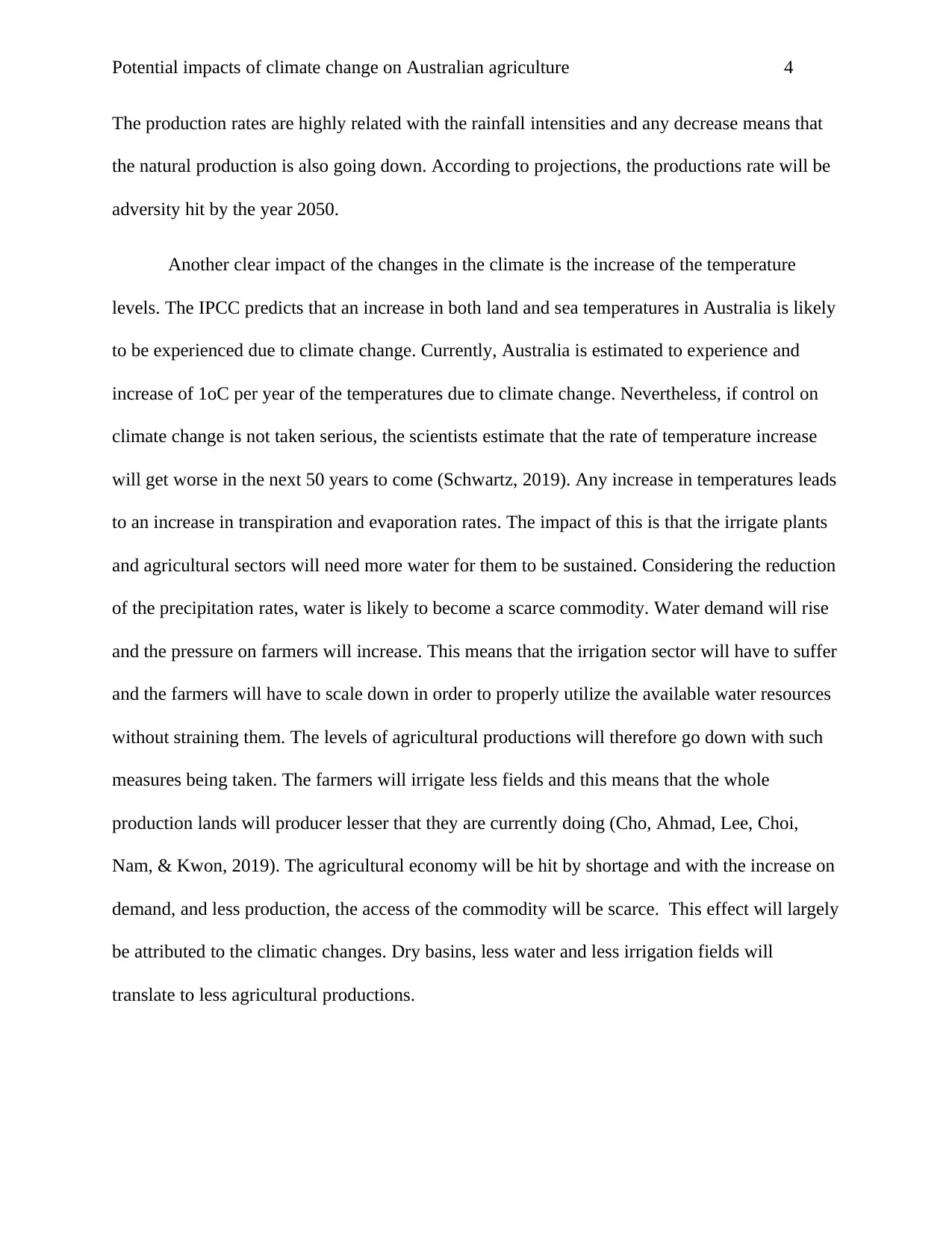
Potential impacts of climate change on Australian agriculture 4
The production rates are highly related with the rainfall intensities and any decrease means that
the natural production is also going down. According to projections, the productions rate will be
adversity hit by the year 2050.
Another clear impact of the changes in the climate is the increase of the temperature
levels. The IPCC predicts that an increase in both land and sea temperatures in Australia is likely
to be experienced due to climate change. Currently, Australia is estimated to experience and
increase of 1oC per year of the temperatures due to climate change. Nevertheless, if control on
climate change is not taken serious, the scientists estimate that the rate of temperature increase
will get worse in the next 50 years to come (Schwartz, 2019). Any increase in temperatures leads
to an increase in transpiration and evaporation rates. The impact of this is that the irrigate plants
and agricultural sectors will need more water for them to be sustained. Considering the reduction
of the precipitation rates, water is likely to become a scarce commodity. Water demand will rise
and the pressure on farmers will increase. This means that the irrigation sector will have to suffer
and the farmers will have to scale down in order to properly utilize the available water resources
without straining them. The levels of agricultural productions will therefore go down with such
measures being taken. The farmers will irrigate less fields and this means that the whole
production lands will producer lesser that they are currently doing (Cho, Ahmad, Lee, Choi,
Nam, & Kwon, 2019). The agricultural economy will be hit by shortage and with the increase on
demand, and less production, the access of the commodity will be scarce. This effect will largely
be attributed to the climatic changes. Dry basins, less water and less irrigation fields will
translate to less agricultural productions.
The production rates are highly related with the rainfall intensities and any decrease means that
the natural production is also going down. According to projections, the productions rate will be
adversity hit by the year 2050.
Another clear impact of the changes in the climate is the increase of the temperature
levels. The IPCC predicts that an increase in both land and sea temperatures in Australia is likely
to be experienced due to climate change. Currently, Australia is estimated to experience and
increase of 1oC per year of the temperatures due to climate change. Nevertheless, if control on
climate change is not taken serious, the scientists estimate that the rate of temperature increase
will get worse in the next 50 years to come (Schwartz, 2019). Any increase in temperatures leads
to an increase in transpiration and evaporation rates. The impact of this is that the irrigate plants
and agricultural sectors will need more water for them to be sustained. Considering the reduction
of the precipitation rates, water is likely to become a scarce commodity. Water demand will rise
and the pressure on farmers will increase. This means that the irrigation sector will have to suffer
and the farmers will have to scale down in order to properly utilize the available water resources
without straining them. The levels of agricultural productions will therefore go down with such
measures being taken. The farmers will irrigate less fields and this means that the whole
production lands will producer lesser that they are currently doing (Cho, Ahmad, Lee, Choi,
Nam, & Kwon, 2019). The agricultural economy will be hit by shortage and with the increase on
demand, and less production, the access of the commodity will be scarce. This effect will largely
be attributed to the climatic changes. Dry basins, less water and less irrigation fields will
translate to less agricultural productions.
Paraphrase This Document
Need a fresh take? Get an instant paraphrase of this document with our AI Paraphraser
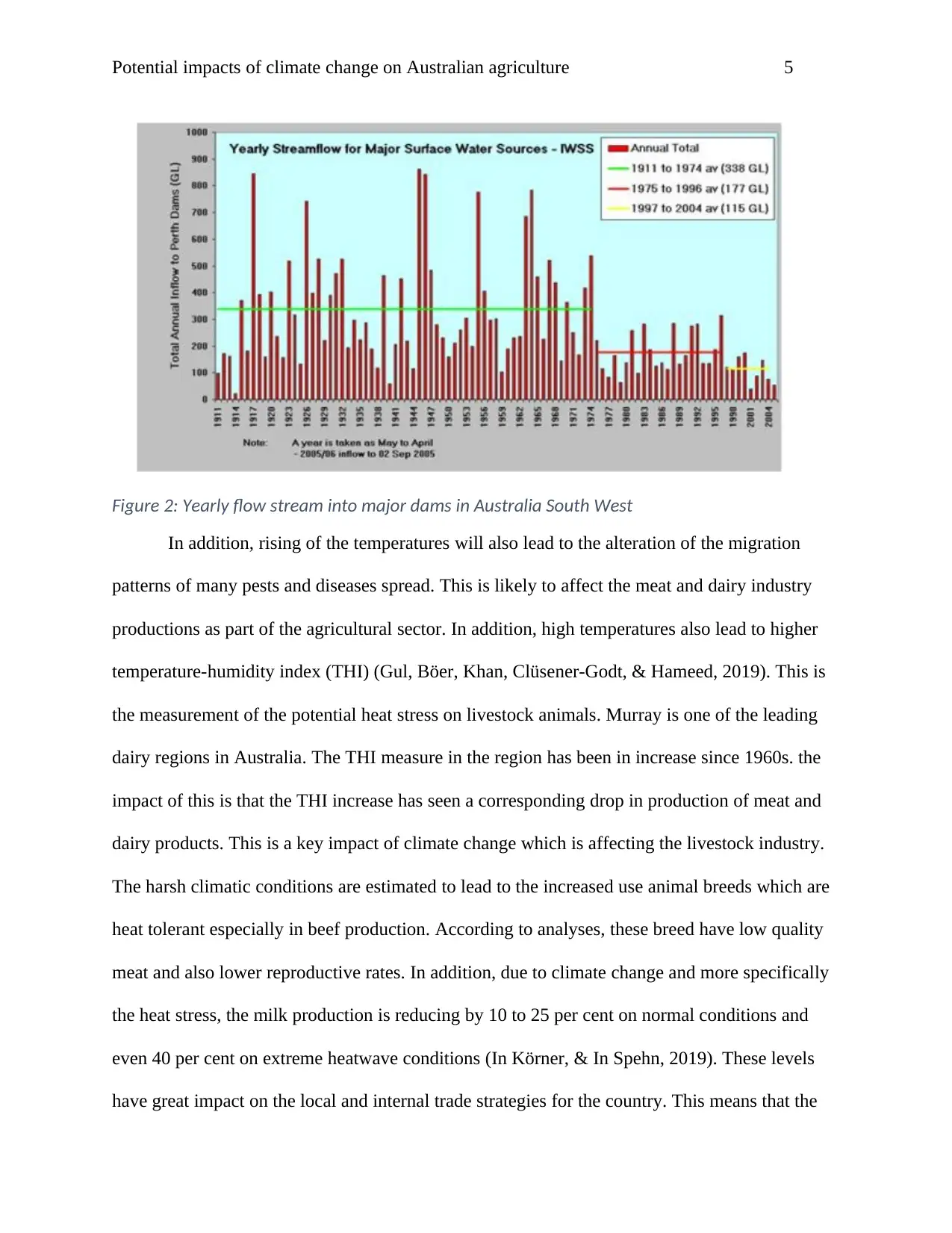
Potential impacts of climate change on Australian agriculture 5
Figure 2: Yearly flow stream into major dams in Australia South West
In addition, rising of the temperatures will also lead to the alteration of the migration
patterns of many pests and diseases spread. This is likely to affect the meat and dairy industry
productions as part of the agricultural sector. In addition, high temperatures also lead to higher
temperature-humidity index (THI) (Gul, Böer, Khan, Clüsener-Godt, & Hameed, 2019). This is
the measurement of the potential heat stress on livestock animals. Murray is one of the leading
dairy regions in Australia. The THI measure in the region has been in increase since 1960s. the
impact of this is that the THI increase has seen a corresponding drop in production of meat and
dairy products. This is a key impact of climate change which is affecting the livestock industry.
The harsh climatic conditions are estimated to lead to the increased use animal breeds which are
heat tolerant especially in beef production. According to analyses, these breed have low quality
meat and also lower reproductive rates. In addition, due to climate change and more specifically
the heat stress, the milk production is reducing by 10 to 25 per cent on normal conditions and
even 40 per cent on extreme heatwave conditions (In Körner, & In Spehn, 2019). These levels
have great impact on the local and internal trade strategies for the country. This means that the
Figure 2: Yearly flow stream into major dams in Australia South West
In addition, rising of the temperatures will also lead to the alteration of the migration
patterns of many pests and diseases spread. This is likely to affect the meat and dairy industry
productions as part of the agricultural sector. In addition, high temperatures also lead to higher
temperature-humidity index (THI) (Gul, Böer, Khan, Clüsener-Godt, & Hameed, 2019). This is
the measurement of the potential heat stress on livestock animals. Murray is one of the leading
dairy regions in Australia. The THI measure in the region has been in increase since 1960s. the
impact of this is that the THI increase has seen a corresponding drop in production of meat and
dairy products. This is a key impact of climate change which is affecting the livestock industry.
The harsh climatic conditions are estimated to lead to the increased use animal breeds which are
heat tolerant especially in beef production. According to analyses, these breed have low quality
meat and also lower reproductive rates. In addition, due to climate change and more specifically
the heat stress, the milk production is reducing by 10 to 25 per cent on normal conditions and
even 40 per cent on extreme heatwave conditions (In Körner, & In Spehn, 2019). These levels
have great impact on the local and internal trade strategies for the country. This means that the
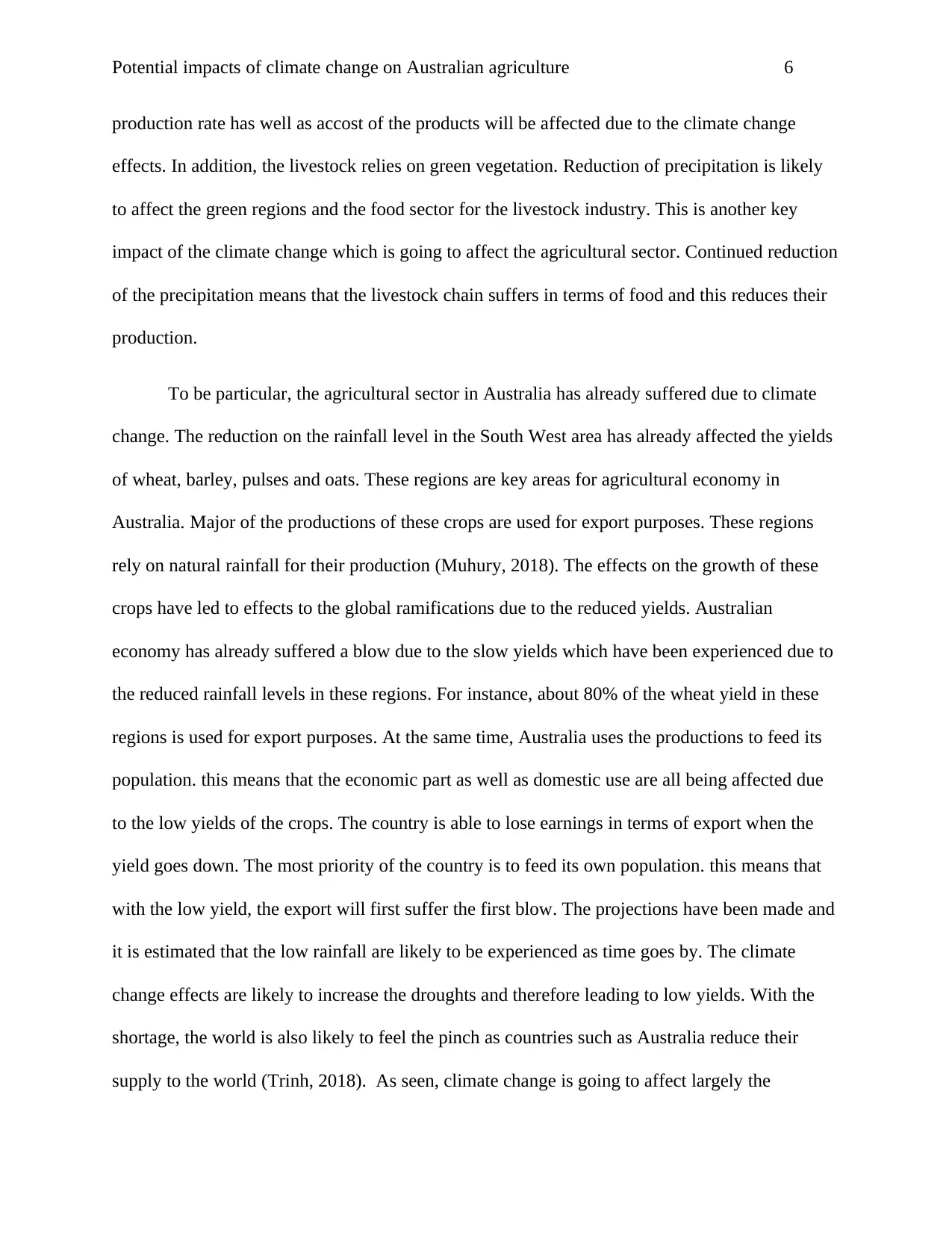
Potential impacts of climate change on Australian agriculture 6
production rate has well as accost of the products will be affected due to the climate change
effects. In addition, the livestock relies on green vegetation. Reduction of precipitation is likely
to affect the green regions and the food sector for the livestock industry. This is another key
impact of the climate change which is going to affect the agricultural sector. Continued reduction
of the precipitation means that the livestock chain suffers in terms of food and this reduces their
production.
To be particular, the agricultural sector in Australia has already suffered due to climate
change. The reduction on the rainfall level in the South West area has already affected the yields
of wheat, barley, pulses and oats. These regions are key areas for agricultural economy in
Australia. Major of the productions of these crops are used for export purposes. These regions
rely on natural rainfall for their production (Muhury, 2018). The effects on the growth of these
crops have led to effects to the global ramifications due to the reduced yields. Australian
economy has already suffered a blow due to the slow yields which have been experienced due to
the reduced rainfall levels in these regions. For instance, about 80% of the wheat yield in these
regions is used for export purposes. At the same time, Australia uses the productions to feed its
population. this means that the economic part as well as domestic use are all being affected due
to the low yields of the crops. The country is able to lose earnings in terms of export when the
yield goes down. The most priority of the country is to feed its own population. this means that
with the low yield, the export will first suffer the first blow. The projections have been made and
it is estimated that the low rainfall are likely to be experienced as time goes by. The climate
change effects are likely to increase the droughts and therefore leading to low yields. With the
shortage, the world is also likely to feel the pinch as countries such as Australia reduce their
supply to the world (Trinh, 2018). As seen, climate change is going to affect largely the
production rate has well as accost of the products will be affected due to the climate change
effects. In addition, the livestock relies on green vegetation. Reduction of precipitation is likely
to affect the green regions and the food sector for the livestock industry. This is another key
impact of the climate change which is going to affect the agricultural sector. Continued reduction
of the precipitation means that the livestock chain suffers in terms of food and this reduces their
production.
To be particular, the agricultural sector in Australia has already suffered due to climate
change. The reduction on the rainfall level in the South West area has already affected the yields
of wheat, barley, pulses and oats. These regions are key areas for agricultural economy in
Australia. Major of the productions of these crops are used for export purposes. These regions
rely on natural rainfall for their production (Muhury, 2018). The effects on the growth of these
crops have led to effects to the global ramifications due to the reduced yields. Australian
economy has already suffered a blow due to the slow yields which have been experienced due to
the reduced rainfall levels in these regions. For instance, about 80% of the wheat yield in these
regions is used for export purposes. At the same time, Australia uses the productions to feed its
population. this means that the economic part as well as domestic use are all being affected due
to the low yields of the crops. The country is able to lose earnings in terms of export when the
yield goes down. The most priority of the country is to feed its own population. this means that
with the low yield, the export will first suffer the first blow. The projections have been made and
it is estimated that the low rainfall are likely to be experienced as time goes by. The climate
change effects are likely to increase the droughts and therefore leading to low yields. With the
shortage, the world is also likely to feel the pinch as countries such as Australia reduce their
supply to the world (Trinh, 2018). As seen, climate change is going to affect largely the
⊘ This is a preview!⊘
Do you want full access?
Subscribe today to unlock all pages.

Trusted by 1+ million students worldwide
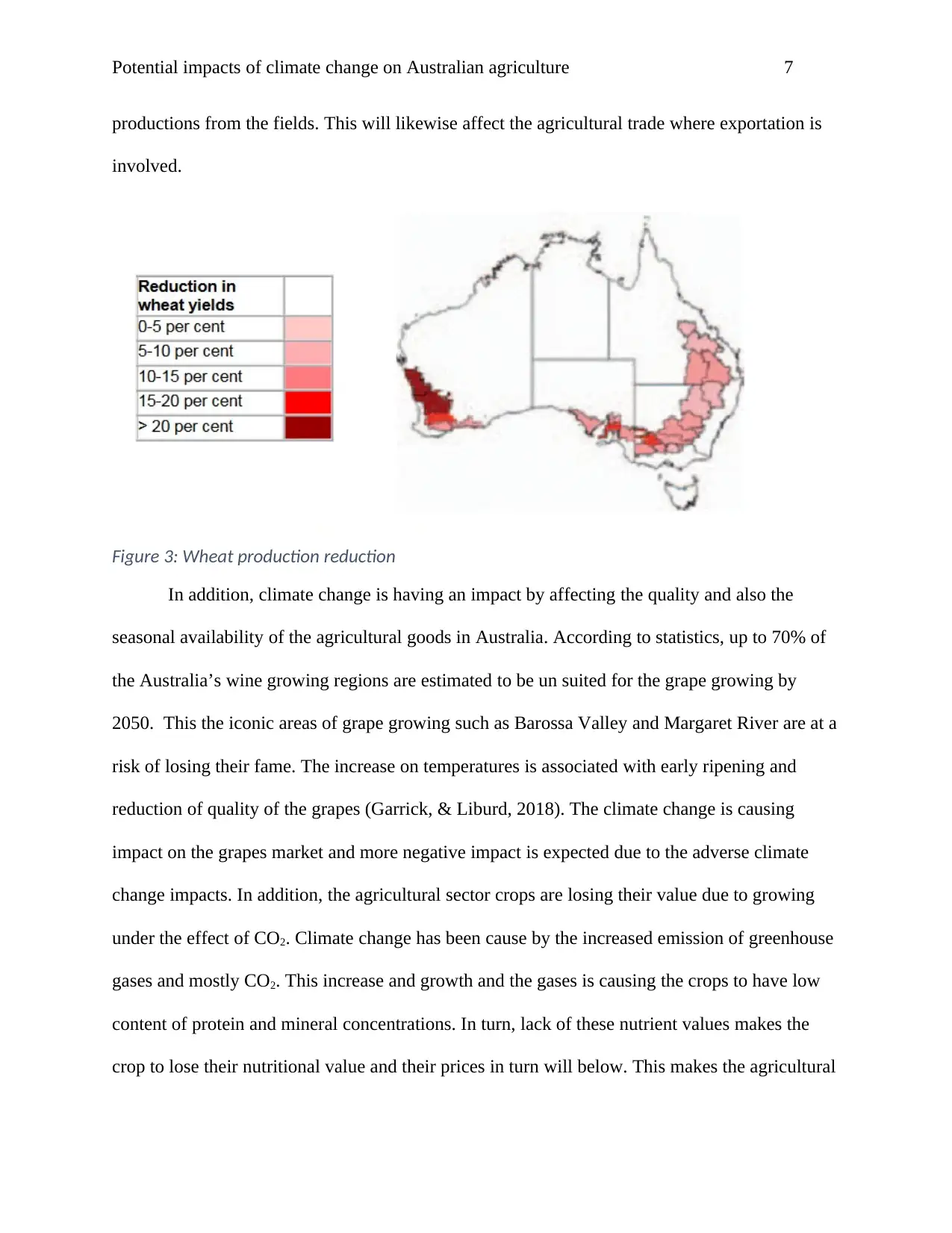
Potential impacts of climate change on Australian agriculture 7
productions from the fields. This will likewise affect the agricultural trade where exportation is
involved.
Figure 3: Wheat production reduction
In addition, climate change is having an impact by affecting the quality and also the
seasonal availability of the agricultural goods in Australia. According to statistics, up to 70% of
the Australia’s wine growing regions are estimated to be un suited for the grape growing by
2050. This the iconic areas of grape growing such as Barossa Valley and Margaret River are at a
risk of losing their fame. The increase on temperatures is associated with early ripening and
reduction of quality of the grapes (Garrick, & Liburd, 2018). The climate change is causing
impact on the grapes market and more negative impact is expected due to the adverse climate
change impacts. In addition, the agricultural sector crops are losing their value due to growing
under the effect of CO2. Climate change has been cause by the increased emission of greenhouse
gases and mostly CO2. This increase and growth and the gases is causing the crops to have low
content of protein and mineral concentrations. In turn, lack of these nutrient values makes the
crop to lose their nutritional value and their prices in turn will below. This makes the agricultural
productions from the fields. This will likewise affect the agricultural trade where exportation is
involved.
Figure 3: Wheat production reduction
In addition, climate change is having an impact by affecting the quality and also the
seasonal availability of the agricultural goods in Australia. According to statistics, up to 70% of
the Australia’s wine growing regions are estimated to be un suited for the grape growing by
2050. This the iconic areas of grape growing such as Barossa Valley and Margaret River are at a
risk of losing their fame. The increase on temperatures is associated with early ripening and
reduction of quality of the grapes (Garrick, & Liburd, 2018). The climate change is causing
impact on the grapes market and more negative impact is expected due to the adverse climate
change impacts. In addition, the agricultural sector crops are losing their value due to growing
under the effect of CO2. Climate change has been cause by the increased emission of greenhouse
gases and mostly CO2. This increase and growth and the gases is causing the crops to have low
content of protein and mineral concentrations. In turn, lack of these nutrient values makes the
crop to lose their nutritional value and their prices in turn will below. This makes the agricultural
Paraphrase This Document
Need a fresh take? Get an instant paraphrase of this document with our AI Paraphraser
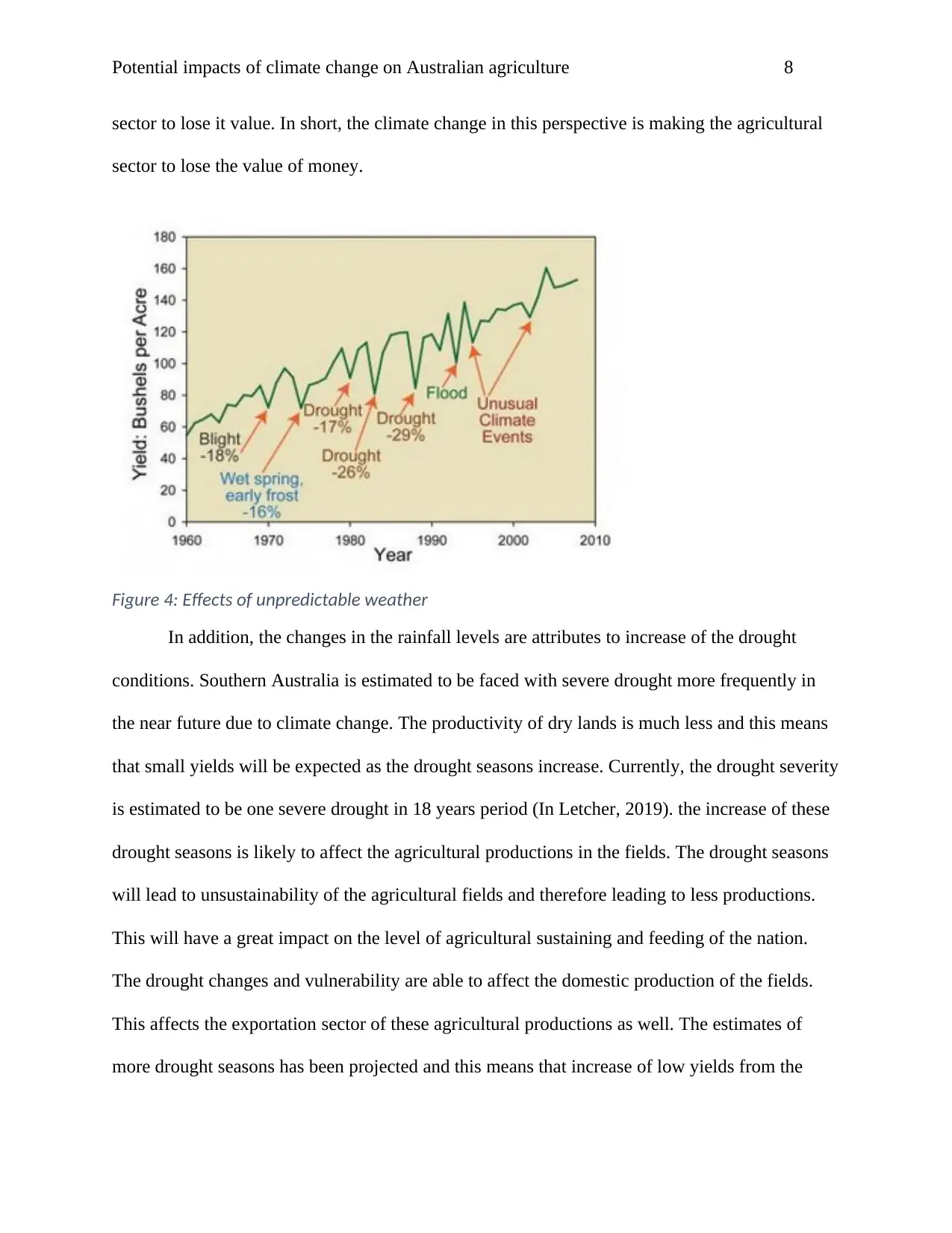
Potential impacts of climate change on Australian agriculture 8
sector to lose it value. In short, the climate change in this perspective is making the agricultural
sector to lose the value of money.
Figure 4: Effects of unpredictable weather
In addition, the changes in the rainfall levels are attributes to increase of the drought
conditions. Southern Australia is estimated to be faced with severe drought more frequently in
the near future due to climate change. The productivity of dry lands is much less and this means
that small yields will be expected as the drought seasons increase. Currently, the drought severity
is estimated to be one severe drought in 18 years period (In Letcher, 2019). the increase of these
drought seasons is likely to affect the agricultural productions in the fields. The drought seasons
will lead to unsustainability of the agricultural fields and therefore leading to less productions.
This will have a great impact on the level of agricultural sustaining and feeding of the nation.
The drought changes and vulnerability are able to affect the domestic production of the fields.
This affects the exportation sector of these agricultural productions as well. The estimates of
more drought seasons has been projected and this means that increase of low yields from the
sector to lose it value. In short, the climate change in this perspective is making the agricultural
sector to lose the value of money.
Figure 4: Effects of unpredictable weather
In addition, the changes in the rainfall levels are attributes to increase of the drought
conditions. Southern Australia is estimated to be faced with severe drought more frequently in
the near future due to climate change. The productivity of dry lands is much less and this means
that small yields will be expected as the drought seasons increase. Currently, the drought severity
is estimated to be one severe drought in 18 years period (In Letcher, 2019). the increase of these
drought seasons is likely to affect the agricultural productions in the fields. The drought seasons
will lead to unsustainability of the agricultural fields and therefore leading to less productions.
This will have a great impact on the level of agricultural sustaining and feeding of the nation.
The drought changes and vulnerability are able to affect the domestic production of the fields.
This affects the exportation sector of these agricultural productions as well. The estimates of
more drought seasons has been projected and this means that increase of low yields from the
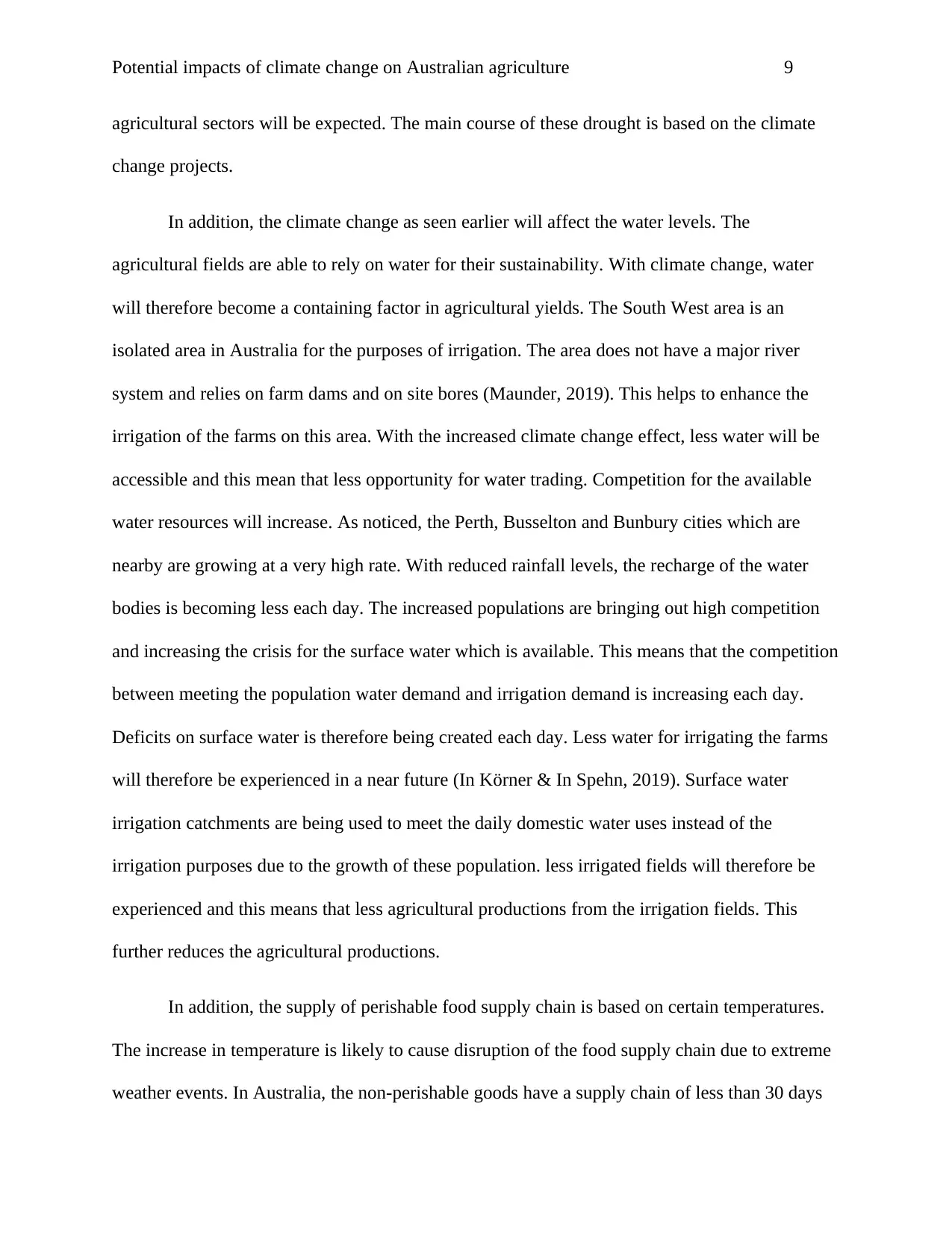
Potential impacts of climate change on Australian agriculture 9
agricultural sectors will be expected. The main course of these drought is based on the climate
change projects.
In addition, the climate change as seen earlier will affect the water levels. The
agricultural fields are able to rely on water for their sustainability. With climate change, water
will therefore become a containing factor in agricultural yields. The South West area is an
isolated area in Australia for the purposes of irrigation. The area does not have a major river
system and relies on farm dams and on site bores (Maunder, 2019). This helps to enhance the
irrigation of the farms on this area. With the increased climate change effect, less water will be
accessible and this mean that less opportunity for water trading. Competition for the available
water resources will increase. As noticed, the Perth, Busselton and Bunbury cities which are
nearby are growing at a very high rate. With reduced rainfall levels, the recharge of the water
bodies is becoming less each day. The increased populations are bringing out high competition
and increasing the crisis for the surface water which is available. This means that the competition
between meeting the population water demand and irrigation demand is increasing each day.
Deficits on surface water is therefore being created each day. Less water for irrigating the farms
will therefore be experienced in a near future (In Körner & In Spehn, 2019). Surface water
irrigation catchments are being used to meet the daily domestic water uses instead of the
irrigation purposes due to the growth of these population. less irrigated fields will therefore be
experienced and this means that less agricultural productions from the irrigation fields. This
further reduces the agricultural productions.
In addition, the supply of perishable food supply chain is based on certain temperatures.
The increase in temperature is likely to cause disruption of the food supply chain due to extreme
weather events. In Australia, the non-perishable goods have a supply chain of less than 30 days
agricultural sectors will be expected. The main course of these drought is based on the climate
change projects.
In addition, the climate change as seen earlier will affect the water levels. The
agricultural fields are able to rely on water for their sustainability. With climate change, water
will therefore become a containing factor in agricultural yields. The South West area is an
isolated area in Australia for the purposes of irrigation. The area does not have a major river
system and relies on farm dams and on site bores (Maunder, 2019). This helps to enhance the
irrigation of the farms on this area. With the increased climate change effect, less water will be
accessible and this mean that less opportunity for water trading. Competition for the available
water resources will increase. As noticed, the Perth, Busselton and Bunbury cities which are
nearby are growing at a very high rate. With reduced rainfall levels, the recharge of the water
bodies is becoming less each day. The increased populations are bringing out high competition
and increasing the crisis for the surface water which is available. This means that the competition
between meeting the population water demand and irrigation demand is increasing each day.
Deficits on surface water is therefore being created each day. Less water for irrigating the farms
will therefore be experienced in a near future (In Körner & In Spehn, 2019). Surface water
irrigation catchments are being used to meet the daily domestic water uses instead of the
irrigation purposes due to the growth of these population. less irrigated fields will therefore be
experienced and this means that less agricultural productions from the irrigation fields. This
further reduces the agricultural productions.
In addition, the supply of perishable food supply chain is based on certain temperatures.
The increase in temperature is likely to cause disruption of the food supply chain due to extreme
weather events. In Australia, the non-perishable goods have a supply chain of less than 30 days
⊘ This is a preview!⊘
Do you want full access?
Subscribe today to unlock all pages.

Trusted by 1+ million students worldwide
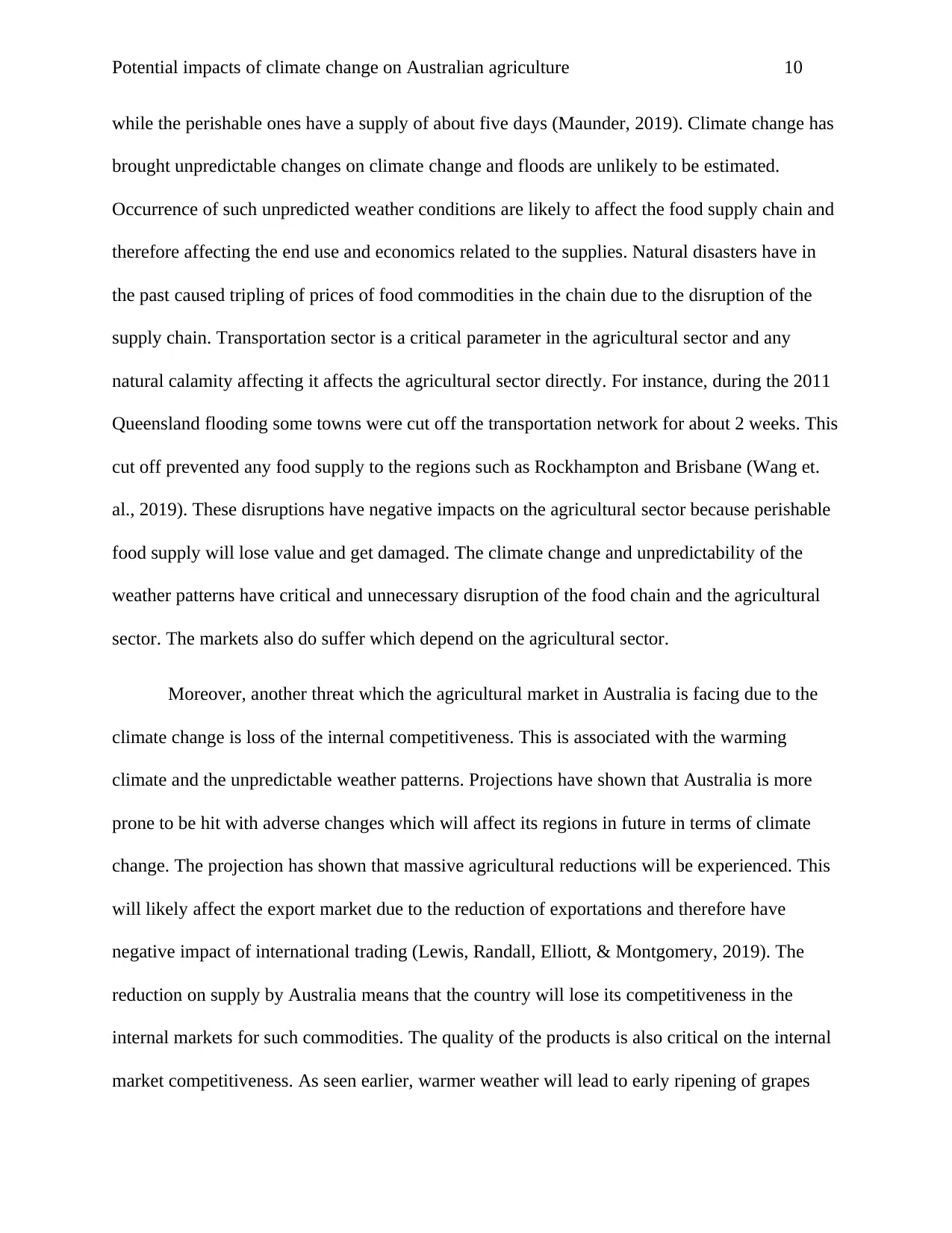
Potential impacts of climate change on Australian agriculture 10
while the perishable ones have a supply of about five days (Maunder, 2019). Climate change has
brought unpredictable changes on climate change and floods are unlikely to be estimated.
Occurrence of such unpredicted weather conditions are likely to affect the food supply chain and
therefore affecting the end use and economics related to the supplies. Natural disasters have in
the past caused tripling of prices of food commodities in the chain due to the disruption of the
supply chain. Transportation sector is a critical parameter in the agricultural sector and any
natural calamity affecting it affects the agricultural sector directly. For instance, during the 2011
Queensland flooding some towns were cut off the transportation network for about 2 weeks. This
cut off prevented any food supply to the regions such as Rockhampton and Brisbane (Wang et.
al., 2019). These disruptions have negative impacts on the agricultural sector because perishable
food supply will lose value and get damaged. The climate change and unpredictability of the
weather patterns have critical and unnecessary disruption of the food chain and the agricultural
sector. The markets also do suffer which depend on the agricultural sector.
Moreover, another threat which the agricultural market in Australia is facing due to the
climate change is loss of the internal competitiveness. This is associated with the warming
climate and the unpredictable weather patterns. Projections have shown that Australia is more
prone to be hit with adverse changes which will affect its regions in future in terms of climate
change. The projection has shown that massive agricultural reductions will be experienced. This
will likely affect the export market due to the reduction of exportations and therefore have
negative impact of international trading (Lewis, Randall, Elliott, & Montgomery, 2019). The
reduction on supply by Australia means that the country will lose its competitiveness in the
internal markets for such commodities. The quality of the products is also critical on the internal
market competitiveness. As seen earlier, warmer weather will lead to early ripening of grapes
while the perishable ones have a supply of about five days (Maunder, 2019). Climate change has
brought unpredictable changes on climate change and floods are unlikely to be estimated.
Occurrence of such unpredicted weather conditions are likely to affect the food supply chain and
therefore affecting the end use and economics related to the supplies. Natural disasters have in
the past caused tripling of prices of food commodities in the chain due to the disruption of the
supply chain. Transportation sector is a critical parameter in the agricultural sector and any
natural calamity affecting it affects the agricultural sector directly. For instance, during the 2011
Queensland flooding some towns were cut off the transportation network for about 2 weeks. This
cut off prevented any food supply to the regions such as Rockhampton and Brisbane (Wang et.
al., 2019). These disruptions have negative impacts on the agricultural sector because perishable
food supply will lose value and get damaged. The climate change and unpredictability of the
weather patterns have critical and unnecessary disruption of the food chain and the agricultural
sector. The markets also do suffer which depend on the agricultural sector.
Moreover, another threat which the agricultural market in Australia is facing due to the
climate change is loss of the internal competitiveness. This is associated with the warming
climate and the unpredictable weather patterns. Projections have shown that Australia is more
prone to be hit with adverse changes which will affect its regions in future in terms of climate
change. The projection has shown that massive agricultural reductions will be experienced. This
will likely affect the export market due to the reduction of exportations and therefore have
negative impact of international trading (Lewis, Randall, Elliott, & Montgomery, 2019). The
reduction on supply by Australia means that the country will lose its competitiveness in the
internal markets for such commodities. The quality of the products is also critical on the internal
market competitiveness. As seen earlier, warmer weather will lead to early ripening of grapes
Paraphrase This Document
Need a fresh take? Get an instant paraphrase of this document with our AI Paraphraser
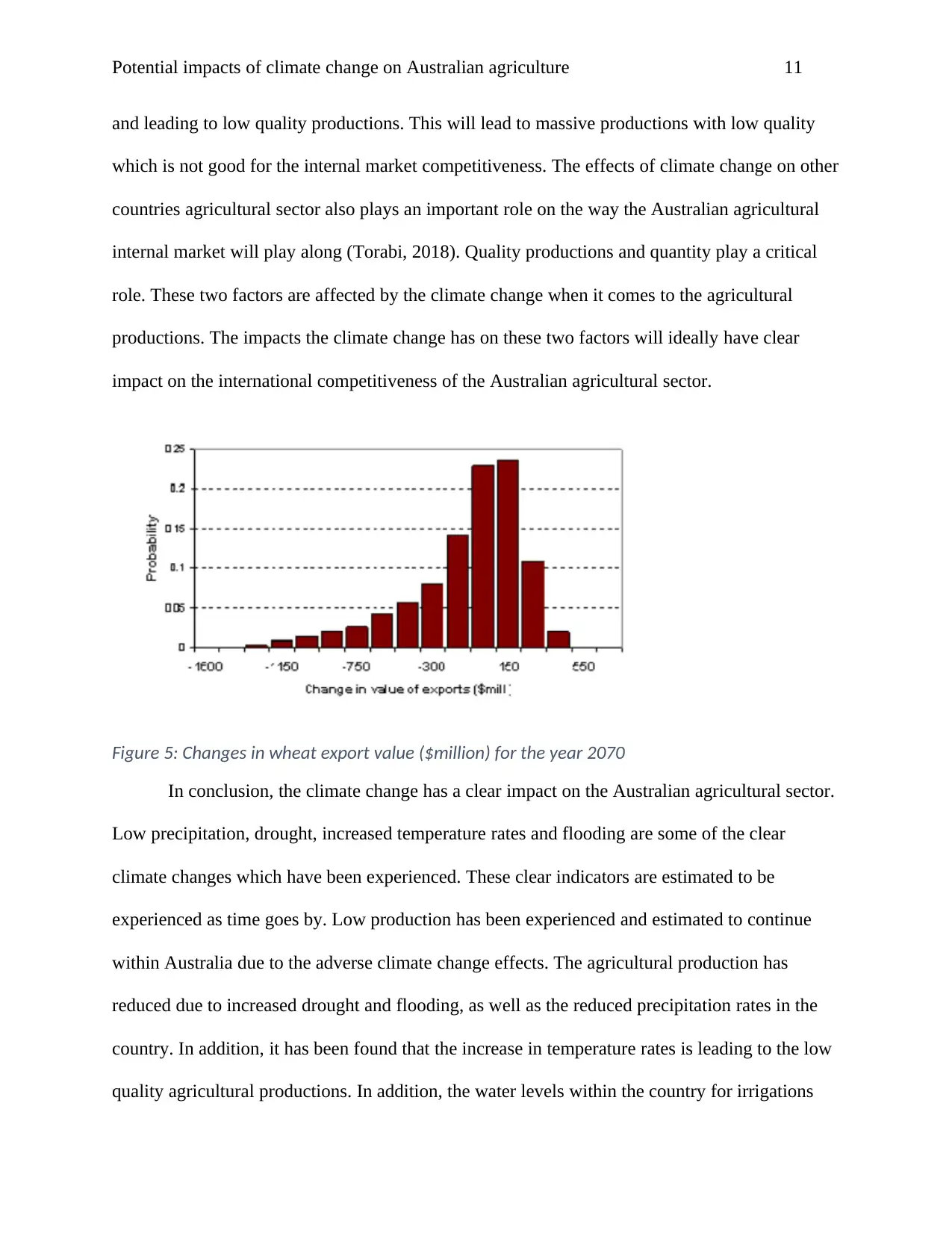
Potential impacts of climate change on Australian agriculture 11
and leading to low quality productions. This will lead to massive productions with low quality
which is not good for the internal market competitiveness. The effects of climate change on other
countries agricultural sector also plays an important role on the way the Australian agricultural
internal market will play along (Torabi, 2018). Quality productions and quantity play a critical
role. These two factors are affected by the climate change when it comes to the agricultural
productions. The impacts the climate change has on these two factors will ideally have clear
impact on the international competitiveness of the Australian agricultural sector.
Figure 5: Changes in wheat export value ($million) for the year 2070
In conclusion, the climate change has a clear impact on the Australian agricultural sector.
Low precipitation, drought, increased temperature rates and flooding are some of the clear
climate changes which have been experienced. These clear indicators are estimated to be
experienced as time goes by. Low production has been experienced and estimated to continue
within Australia due to the adverse climate change effects. The agricultural production has
reduced due to increased drought and flooding, as well as the reduced precipitation rates in the
country. In addition, it has been found that the increase in temperature rates is leading to the low
quality agricultural productions. In addition, the water levels within the country for irrigations
and leading to low quality productions. This will lead to massive productions with low quality
which is not good for the internal market competitiveness. The effects of climate change on other
countries agricultural sector also plays an important role on the way the Australian agricultural
internal market will play along (Torabi, 2018). Quality productions and quantity play a critical
role. These two factors are affected by the climate change when it comes to the agricultural
productions. The impacts the climate change has on these two factors will ideally have clear
impact on the international competitiveness of the Australian agricultural sector.
Figure 5: Changes in wheat export value ($million) for the year 2070
In conclusion, the climate change has a clear impact on the Australian agricultural sector.
Low precipitation, drought, increased temperature rates and flooding are some of the clear
climate changes which have been experienced. These clear indicators are estimated to be
experienced as time goes by. Low production has been experienced and estimated to continue
within Australia due to the adverse climate change effects. The agricultural production has
reduced due to increased drought and flooding, as well as the reduced precipitation rates in the
country. In addition, it has been found that the increase in temperature rates is leading to the low
quality agricultural productions. In addition, the water levels within the country for irrigations
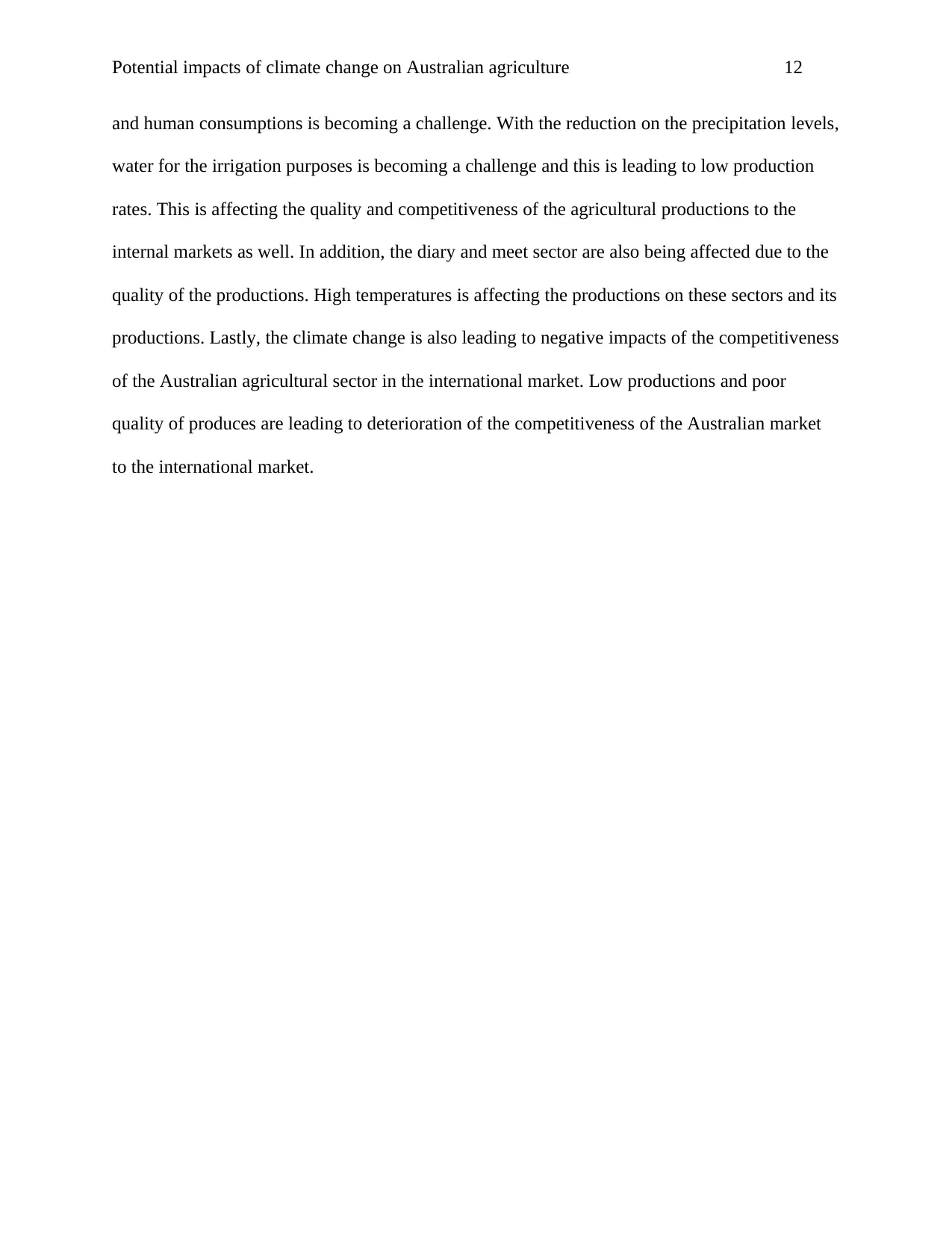
Potential impacts of climate change on Australian agriculture 12
and human consumptions is becoming a challenge. With the reduction on the precipitation levels,
water for the irrigation purposes is becoming a challenge and this is leading to low production
rates. This is affecting the quality and competitiveness of the agricultural productions to the
internal markets as well. In addition, the diary and meet sector are also being affected due to the
quality of the productions. High temperatures is affecting the productions on these sectors and its
productions. Lastly, the climate change is also leading to negative impacts of the competitiveness
of the Australian agricultural sector in the international market. Low productions and poor
quality of produces are leading to deterioration of the competitiveness of the Australian market
to the international market.
and human consumptions is becoming a challenge. With the reduction on the precipitation levels,
water for the irrigation purposes is becoming a challenge and this is leading to low production
rates. This is affecting the quality and competitiveness of the agricultural productions to the
internal markets as well. In addition, the diary and meet sector are also being affected due to the
quality of the productions. High temperatures is affecting the productions on these sectors and its
productions. Lastly, the climate change is also leading to negative impacts of the competitiveness
of the Australian agricultural sector in the international market. Low productions and poor
quality of produces are leading to deterioration of the competitiveness of the Australian market
to the international market.
⊘ This is a preview!⊘
Do you want full access?
Subscribe today to unlock all pages.

Trusted by 1+ million students worldwide
1 out of 14
Related Documents
Your All-in-One AI-Powered Toolkit for Academic Success.
+13062052269
info@desklib.com
Available 24*7 on WhatsApp / Email
![[object Object]](/_next/static/media/star-bottom.7253800d.svg)
Unlock your academic potential
Copyright © 2020–2025 A2Z Services. All Rights Reserved. Developed and managed by ZUCOL.




